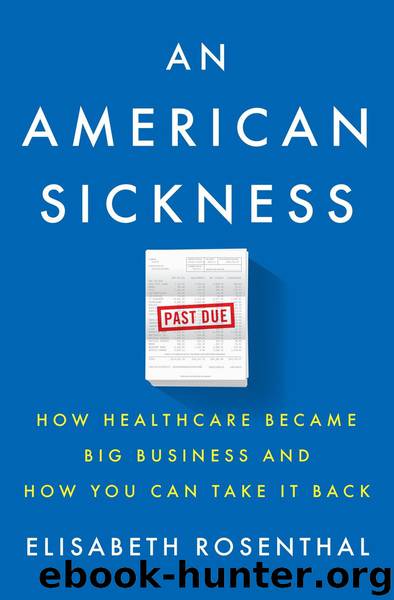An American Sickness by Elisabeth Rosenthal

Author:Elisabeth Rosenthal
Language: eng
Format: epub
Publisher: Penguin Publishing Group
Published: 2017-03-28T11:00:43+00:00
A Part-Time Emergency Room
New York State assemblyman James Skoufis represents five towns about fifty miles north of New York City in the Hudson Valley. Much of his first term in office had been consumed by preventing attempts to gut some essential services at the community’s health provider, Cornwall Hospital, or St. Luke’s Cornwall Hospital, as it is now called.
Cornwall Hospital, which opened its doors in 1931, was founded with a grant from a doctor, Ernest Stillman, who explained:
Some years ago I was asked to see a sick child. As the patient was in dire need of hospital care to save her life, I rushed her in my car to an adjacent hospital. But the hospital would not admit the patient and the child died. That tragedy marks the starting of the Cornwall Hospital.
The little hospital prospered with its community, adding forty beds in the 1960s and thriving with the generous healthcare payments of the 1980s. In 1982 the hospital opened a ten-bed intensive care/coronary care unit; in 1986 it added an ambulatory surgery suite; and in 1990 it cut the ribbon on an endoscopy center.
But the HMO era in the 1990s hit the hospital’s pocketbook hard, and, in 2002, it merged with a somewhat larger area provider, St. Luke’s in Newburgh. At Cornwall, over the course of the next decade, services were slowly pared down: by 2013 inpatient care, the operating room, mental health, the maternity ward, radiology, and the labs had all been eliminated.
By the time Skoufis took office in 2013, St. Luke’s had over two hundred beds, while the Cornwall campus was, in his words, “a ghost town”; the only services left were a cancer treatment center operated by a contractor and the hospital’s emergency room. On September 9, 2013, St. Luke’s management circulated a draft press release announcing that it henceforth planned to operate the Cornwall emergency room only part-time, closing it from 10 p.m. to 10 a.m. each day, since it was losing money by staying open at night.
In the past decades, emergency room care has been quickly commercialized, governed often not by patient needs but by finances. Many states—notably Texas and Colorado—have permitted the opening of freestanding ERs often owned by entrepreneurial physicians. If a patient arrives via ambulance and is seriously injured or really sick or has had a heart attack, a doctor checks him out and sends him to the nearest real emergency department connected to a hospital with facilities like operating rooms and a cardiac laboratory. Aside from the risk of delays in treatment, the sequence results in bills for two separate high-level ER visits and a charge for emergency transport.
Most states that allow freestanding ERs at least insist they stay open 24/7 and take all emergencies regardless of the ability of customers to pay—though they cannot accept Medicare or Medicaid, since government insurers insist that to qualify as an ER and bill ER rates, an emergency room must be physically connected to a hospital.
Management in Cornwall tried to take the freestanding concept further by closing at night.
Download
This site does not store any files on its server. We only index and link to content provided by other sites. Please contact the content providers to delete copyright contents if any and email us, we'll remove relevant links or contents immediately.
The Secrets of Successful Financial Planning by Dan Gallagher(1170)
A Knight's Reward by Catherine Kean(1101)
An American Sickness by Elisabeth Rosenthal(1024)
Against the Gods by Peter L. Bernstein(875)
America's Bitter Pill: Money, Politics, Backroom Deals, and the Fight to Fix Our Broken Healthcare System by Steven Brill(852)
FREAKONOMICS by levitt steven d(847)
SuperFreakonomics by Steven D. Levitt(832)
America's Bitter Pill by Steven Brill(808)
Risk Management Framework by James Broad(798)
2019 Social Security & Medicare Facts by Michael D. Thomas(785)
A Practical Introduction to Security and Risk Management by Bruce Oliver Newsome(776)
Strategic Risk Taking: A Framework for Risk Management by Aswath Damodaran(774)
Game Changers by Rudolf Taschner(759)
How Our Days Became Numbered: Risk and the Rise of the Statistical Individual by Dan Bouk(741)
The New Frontier Investors by Jagdeep Singh Bachher Adam D. Dixon & Ashby H. B. Monk(733)
The Globetrotter's Guide to Travel Insurance: Travel Smarter, Pay Less, Get the Right Coverge (The Savvy Traveler Series Book 1) by Bauche Michael & Bauche Yvonne(712)
The 8 Characteristics of the Awesome Adjuster by Carl van Lamsweerde(705)
SUPERFREAKONOMICS by levitt steven d(699)
The Advisor Playbook: Regain Liberation and Order in your Personal and Professional Life by Duncan MacPherson & Chris Jeppesen(662)
